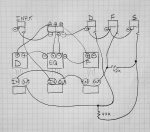Danbieranowski
Well-known member
Hey all, This is a pretty ridiculous pedal setup, but a friend of mine wants it, so I'm gonna try it!
It's 3 pedals in a single enclosure, an EQ (Zapper), a Fuzz (Russian Muff), and a Distortion (Rat).
When looking at it from above he wants it in this order: Left - Fuzz, Middle - EQ, Right - Distortion
The order that he wants the wiring to work:
Input to hit the EQ first.
Then from the EQ split to the fuzz and to the distortion separately.
Then fuzz to its own output (Fuzz Out).
Distortion to its own output (Dist Out).
Fuzz and Distortion outputs ALSO both get sent to a summed output (not running one into the other, but directly off the output of each to a summed out).
The goal for this is that he plays an SVT with two inputs. He normally runs separate pedals into each channel (fuzz into one, distortion into the other) then mixes to taste. This will allow him to consolidate his board, but it will also allow him to get the same kind of gnarly tone on amps with only a single input instead of two inputs.
From what I understand about mA ratings on these circuits, they are very low, so combining into a single 100mA line probably wouldn't be a problem (?).
Anyways, the difficult part is obviously the internal wiring. I put together this diagram and I was just hoping someone with a bigger brain than mine can take a peek and tell me if it's solid. As always, this forum rules and thank you!
Here's the layout:
Green wire - From input to in of EQ.
Yellow wires - Out of EQ into input of Rat and Muff.
Blue wire - out of Rat to Distortion out.
Pink wire - Out of Muff to Fuzz Out.
Orange Wires - Out of Muff and Rat to Summed out.
DC Board - Handles power for each circuit.
Grounds (black wires) - I have these wired kind of weird. I just assume that each 1/4" Jack needs to be connected to the ground from any one of the boards (not sure if I'm understanding this correctly and ALL boards need to ground to EACH in and out).
Anyways, please rip this apart if it doesn't make sense so I can try to work this out in my brain. Thanks a bunch!

It's 3 pedals in a single enclosure, an EQ (Zapper), a Fuzz (Russian Muff), and a Distortion (Rat).
When looking at it from above he wants it in this order: Left - Fuzz, Middle - EQ, Right - Distortion
The order that he wants the wiring to work:
Input to hit the EQ first.
Then from the EQ split to the fuzz and to the distortion separately.
Then fuzz to its own output (Fuzz Out).
Distortion to its own output (Dist Out).
Fuzz and Distortion outputs ALSO both get sent to a summed output (not running one into the other, but directly off the output of each to a summed out).
The goal for this is that he plays an SVT with two inputs. He normally runs separate pedals into each channel (fuzz into one, distortion into the other) then mixes to taste. This will allow him to consolidate his board, but it will also allow him to get the same kind of gnarly tone on amps with only a single input instead of two inputs.
From what I understand about mA ratings on these circuits, they are very low, so combining into a single 100mA line probably wouldn't be a problem (?).
Anyways, the difficult part is obviously the internal wiring. I put together this diagram and I was just hoping someone with a bigger brain than mine can take a peek and tell me if it's solid. As always, this forum rules and thank you!
Here's the layout:
Green wire - From input to in of EQ.
Yellow wires - Out of EQ into input of Rat and Muff.
Blue wire - out of Rat to Distortion out.
Pink wire - Out of Muff to Fuzz Out.
Orange Wires - Out of Muff and Rat to Summed out.
DC Board - Handles power for each circuit.
Grounds (black wires) - I have these wired kind of weird. I just assume that each 1/4" Jack needs to be connected to the ground from any one of the boards (not sure if I'm understanding this correctly and ALL boards need to ground to EACH in and out).
Anyways, please rip this apart if it doesn't make sense so I can try to work this out in my brain. Thanks a bunch!



